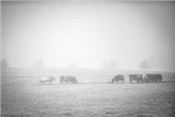|
Getting Through Winter Cold Can Be Stressful For Farm Animals

Photo courtesy Aimee Nielson, UK Agricultural Communications Specialist
LEXINGTON, KY.
After a few weeks of above-average temperatures, Kentuckians will feel the chill with an early-January cold snap.
University of Kentucky agricultural meteorologist Matt Dixon explained that the combination of cold air and winds create dangerous and emergency-category periods of livestock cold stress.
Livestock producers should make sure animals have adequate shelter, water, dry bedding and feed to make it through cold spells. Pet owners should bring pets indoors. UK livestock specialists said animals have a higher requirement for energy in the colder months, so producers should have high-quality grains and forages on hand to meet their needs.
“The average horse, with a lower activity level, should eat between 1.5 and 2 percent of its body weight in feed per day to maintain its weight,” said Bob Coleman, equine extension specialist in the UK College of Agriculture, Food and Environment. “That feed requirement goes up in the winter as the horse uses more calories to keep warm.”
He recommended providing extra hay and making sure horses have shelter to get out of windy, damp weather. It’s important for horses and all livestock to have access to clean, unfrozen water.
Ambient temperatures can impact the amount of dry matter cattle eat, providing an opportunity to compensate for increased maintenance energy needs. Producers either need to increase their animals’ feed intake or increase the energy density of the diet by feeding higher quality hay or adding more grain or fat to the grain mix, said UK beef specialist Jeff Lehmkuhler.
Lehmkuhler recommended that producers continue to monitor cows during the wintertime and make sure to maintain a healthy body condition.
“Poor quality hay may not provide adequate energy to maintain gestating cows that are entering the third trimester,” he said. “Consider having hay tested to determine if you need to supplement during times of possible cold stress, especially for the enduring cold spells.”
He said to consider separating younger and thinner cows that may not have the same internal insulation as conditioned older cows and supplement them accordingly or offer them higher quality forage if available. Horse owners can employ similar strategies and separate animals according to body condition score.
“Producers should move cows to fields with natural windbreaks or provide man-made windbreaks, which are not the same as a barn,” Lehmkuhler suggested. “Poorly managed barns combined with poor ventilation may actually hamper efforts to improve the environmental conditions. Lastly, remember it is energy or calories that are really needed. If the protein level in the forage is adequate, do not make supplement decisions based on protein level; rather purchase the most affordable calories.”
The lower critical temperature value for cattle is the lowest temperature or wind chill at which no additional energy is required to maintain core body temperature.
“As the temperature declines below this lower critical value, the maintenance energy value for the animal is increased to maintain core body temperature,” he said. “Animals maintain core body temperature by increasing their metabolism resulting in greater heat production, as well as other heat conservation strategies such as reducing blood flow to the extremities, shivering and increased intake.”
Lehmkuhler said several things can influence lower critical temperature value.
“Both external and internal insulation influence the LCT. External insulation is basically the depth and thickness of the hair coat, condition of the hair coat and thickness of the hide,” he said. “Thin-hided breeds such as dairy breeds tend to have a lower insulating factor than thick-hided breeds like Herefords.”
The hair coat acts as insulation similar to home attic insulation that traps air, enhancing the insulating value. If the hair is wet and full of mud, air is excluded, reducing the insulating value and increasing heat loss from the skin. Hair coat characteristics, such as density and moisture level, impact the temperatures at which cold stress is considered mild, moderate or severe. As little as 0.1 inch of rain can immediately impact cold stress severity by matting the hair down reducing its insulating ability. Acclimation time, hide thickness, fat cover and other factors will also influence the degree of cold stress that animals experience.
For dairy animals, producers should make sure teats are dry before turning animals out when temperatures fall below 25 degrees Fahrenheit.
Treat signs of frostbite immediately, since damage to the teat ends can quickly lead to damage of the keratin seal. That can, in turn, allow mastitis-causing bacteria to enter the udder.
“If you turn out an animal with a wet udder or teats, frostbite is almost a certainty,” said Michelle Arnold, UK extension veterinarian.
The key is to give animals a draft-free place to get out of the wind during extreme wind chill conditions.
“The challenge is to make that space available and still provide enough ventilation to allow fresh air to circulate,” she said.
Dry bedding is also very important. If cows, goats or sheep lie in wet bedding, frostbite is a big risk. Producers also need to make sure the animals’ hair coats are kept dry and as clean as possible.
“Perhaps the most important thing producers can do is to take care of themselves in extreme cold,” Arnold said. “If you get into trouble, you can’t be the caregiver to your livestock that you want to be.”
Keep an extra set of clothes and a blanket in the truck. An extra pair of dry boots is a great plan as well. ∆
|
|